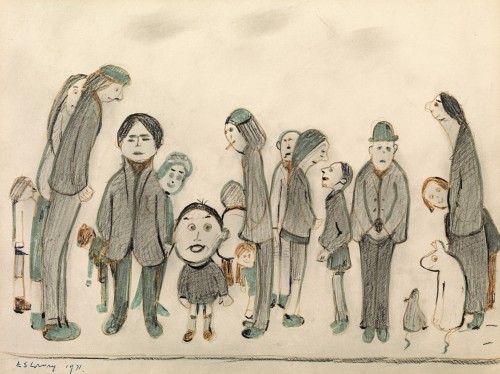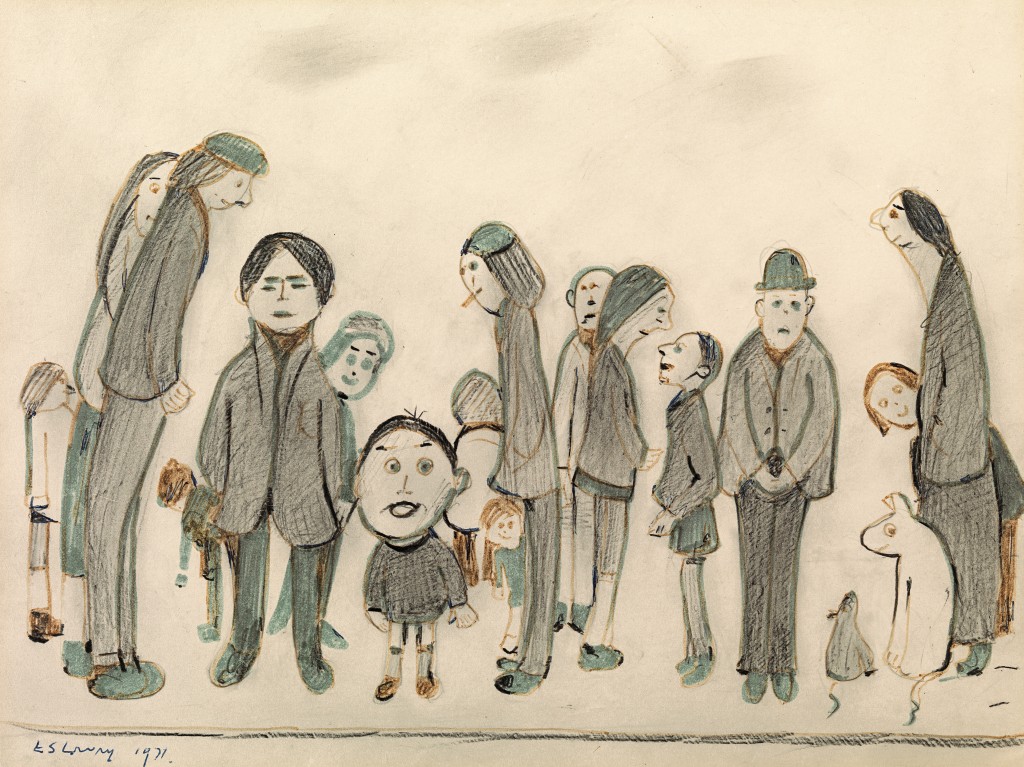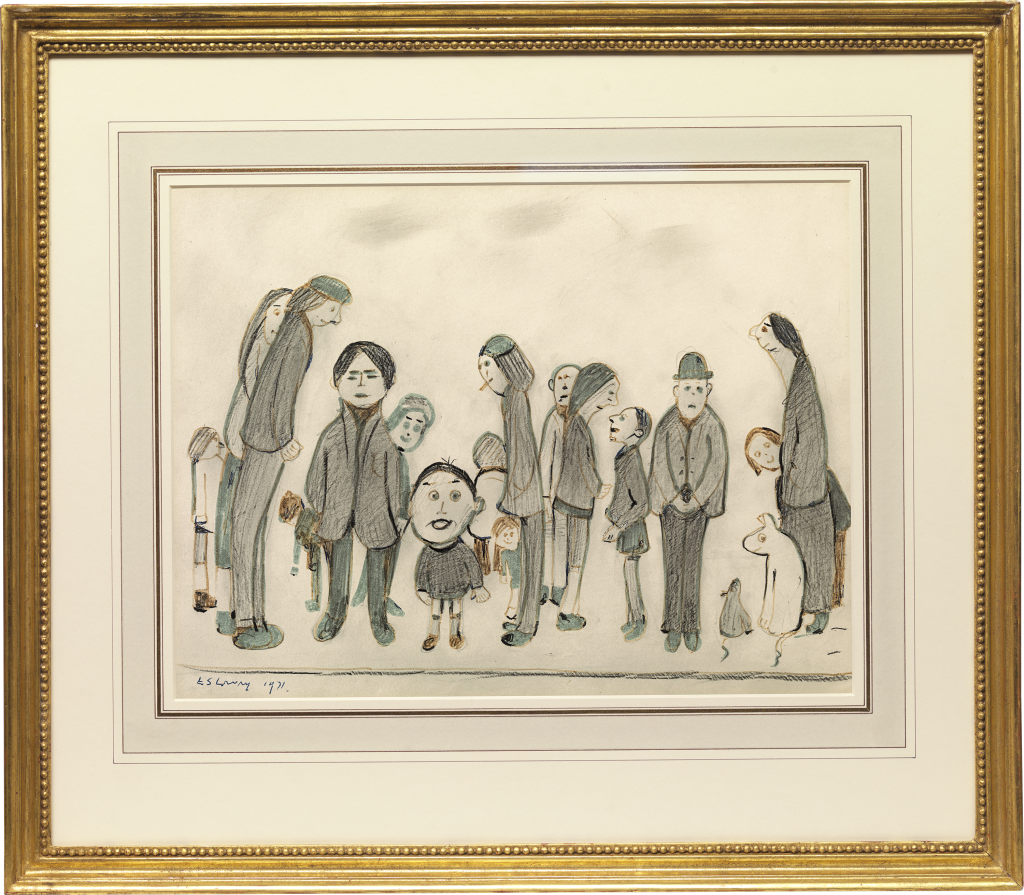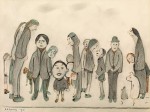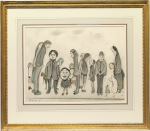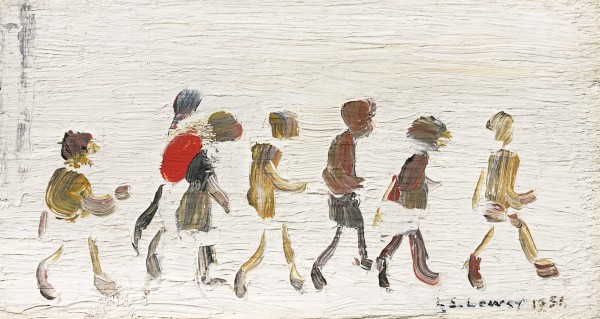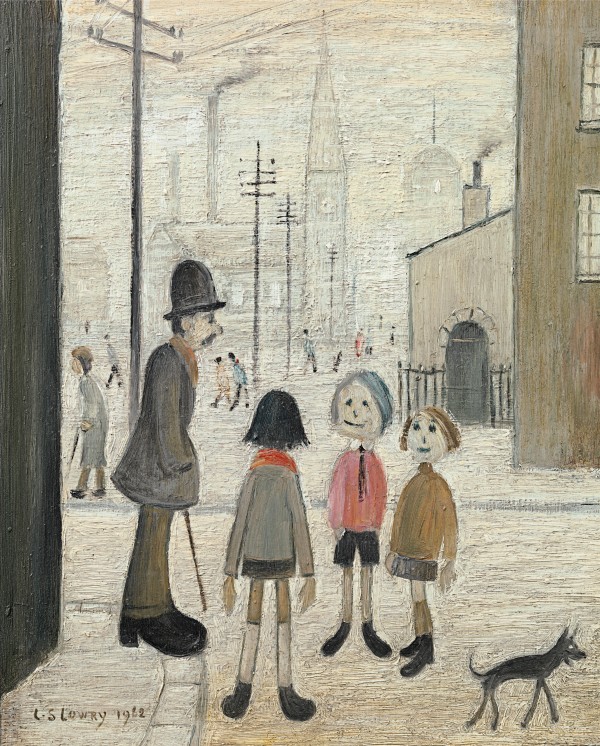LAURENCE STEPHEN LOWRY RA RBA LG NS
Manchester 1887 - 1976 Glossop
Ref: CC 138
Study of people and animals
Signed and dated lower left: LS LOWRY 1971
Pencil, ink, crayon and felt tip pen on paper:
8 ¾ x 11 ¼ in / 22.2 x 28.6 cm
Frame size: 17 x 19 ½ in / 43.2 x 49.5 cm
Provenance:
J Davey & Sons, Manchester
Private collection
Sotheby’s London, 14th March 1979, lot 116;
Peter Barkworth (1929-2006), Hampstead, then by descent to David Wyn Jones (1952-2023), Folkestone, then by family descent
It seems fitting given Lowry’s love of the theatre that this dramatic work was previously owned by the Bafta-winning actor, Peter Barkworth, whose many roles on stage and screen included Where Eagles Dare, Wilde, Dr Who, The Avengers, Crown Matrimonial and Telford’s Change. Barkworth was also a great art collector and at his death bequeathed fifty-five paintings and drawings to the National Trust to be hung at Fenton House in Hampstead, including works by John Constable, Laura Knight, Walter Sickert, Duncan Grant and Paul Nash.[1] The present work was inherited by his partner, David Wyn Jones, former Director of Acting at Guildhall School. On a note attached to the reverse, Barkworth wrote: ‘Its always been a favourite.’
Lowry was particularly fond of drawing in pencil often using it to produce more detailed work than is seen in his oil paintings. In his book, The Drawings of LS Lowry, Public and Private, Mervyn Levy recalls that Lowry once commented ‘Can you tell me, sir, why does a painting cost more than a drawing? After all, a drawing is every bit as important, and sometimes a damned sight more effective. Besides, it is more difficult to do; for one thing, you haven’t got colour to get you out of a mess.’[2] Lowry used coloured chalks and pencils, and later ballpoint and felt tip pen, as in the present work, skilfully adding detail, depth and diversity to this fantastic group of characters. Throughout his career he employed a variety of drawing techniques and frequently used finger smudging to achieve different textures and velvety tones of black and grey, to imbue the distinctive atmosphere of the industrial north or typically English weather. His drawings are an important element of his oeuvre, grounded in the traditional drawing skills that he learnt from his teacher, Adolphe Valette (1876-1942). They are immediate, forceful, modern and often comic works of art. His figure drawings show the same complex of characteristics that are found in his paintings and his expressive use of pencil gives these works unique delicacy and depth of expression.
LAURENCE STEPHEN LOWRY RA RBA LG NS
Manchester 1887 - 1976 Glossop
Sir Hugh Casson, in his preface to the 1976 Royal Academy Memorial exhibition, referred to LS Lowry as ‘one of the great English painters of this century.’ An individual artist with a unique style, Lowry’s work spans the first half of the twentieth century, recording with sensitivity and wit his own personal view of the people and architecture of the industrial north.
Born in Manchester in 1887, Laurence Stephen Lowry was the only child of Robert and Elizabeth Lowry. He started drawing at the age of eight and in 1903 began private painting classes which marked the start of a part-time education in art that was to continue for twenty years. In 1904, aged 16, he left school and secured a job as a clerk in a chartered accountants’ firm; he remained in full-time employment until his retirement at the age of 65. His desire to be considered a serious artist led him to keep his professional and artistic life completely separate and it was not disclosed until after his death that he had worked for most of his life.
Lowry’s early training was at the Municipal College of Art, Manchester. There he was taught by the French artist Adolphe Valette who introduced him to Impressionism and of whom he said: ‘I owe so much to him for it was he who first showed me good drawings by the great masters…he gave me the feeling that life drawing was a very wonderful thing.’ Lowry was, however, unaffected by Valette’s impressionist technique and continued to develop a more realistic approach to his art.
In 1909 Lowry and his parents moved to Pendlebury, where initially he was not happy, and for some years ignored his surroundings. In 1916, whilst waiting for a train, he became fascinated by the workers leaving the Acme Spinning Company Mill; the combination of the people and the surroundings was a revelation to him and marked the turning point in his artistic career. He now began to explore the industrial areas of South Lancashire and discovered a wealth of inspiration, remarking ‘My subjects were all around me…in those days there were mills and collieries all around Pendlebury. The people who work there were passing morning and night. All my material was on my doorstep.’
By 1920 Lowry’s street scenes, peopled with workers, housewives and children set against a backdrop of industrial buildings and terraced houses, had become central to his highly personal style. From now on he painted entirely from experience and believed that you should ‘paint the place you know.’ His leisure time was spent walking the streets of Manchester and Salford making pencil sketches on scraps of paper and the backs of used envelopes, recording anything that could be used in his work. In his early factory scenes the emphasis is placed on the buildings and the atmosphere was often dark and sombre; however, as he developed this theme the figures became more prominent and eventually he arrived at a marriage between the two where the figures and surroundings form a whole.
By the 1930s Lowry had established his own particular style. He was encouraged by his teacher Bernard Taylor to try to make his figures and buildings stand out more and he began to experiment with setting them against a white background. He chose ‘flake white,’ building up layer after layer on the canvas before painting the subject matter straight on top. He used only four other colours: vermilion, Prussian blue, ivory black and ochre, which he applied straight from the tube.
With the onset of the modernisation of the industrial north in the mid-1950s Lowry lost interest in his surroundings and now concentrated almost entirely on figures silhouetted against a white background, occasionally standing on a hint of a pavement or near a ghost of a wall, but frequently suspended in time and space. He continued to sketch and closely observe his subjects and his works from this period capture the essence of Northern people; he frequently mixes young and old and he imparts to each figure an individual character. Shelley Rohde in A Private View of LS Lowry comments: ‘he had a new obsession, his single figures, his grotesques. The struggling, surging, misshapen homunculi who used to live for so long in the shadow of the mills emerging at last from their background to stand alone, as he stood alone’.
Visits to Wales in the 1960s with his friend and patron Monty Bloom briefly revived Lowry’s interest in industrial scenes. He was impressed by the contrast between the industrial towns and the surrounding countryside; consequently his paintings from this period are brighter than his Lancashire paintings. However, towards the end of the 1960s Lowry began to lose his creative urge and, with the exception of the occasional moment of artistic inspiration, he ceased painting almost entirely.
Laurence Stephen Lowry died of pneumonia in 1976, aged 88. Although he had received critical acclaim for his work during the second half of his life, he never forgot the lack of recognition that he had received initially and he carried with him the feeling of isolation and rejection throughout his career. He refused the offer of a knighthood, as well as numerous other honours, and remained disillusioned with the art world despite the praise that was heaped upon him.
Lowry is remembered as a man of remarkable resilience and sensitivity; he stood alone, unaffected by the influences of other artists and his inspiration came entirely from his own experience. His paintings and drawings are now included in most important private and public collections in the United Kingdom and abroad and his unique works continue to receive the critical acclaim that he so richly deserves.
[1] See Peyton Skipworth, ‘The Peter Barkworth Collection at Fenton House, Hampstead,’ The British Art Journal, Winter 2007/8, vol.8, no.3, pp.55-59.
[2] The artist cited in Mervyn Levy, The Drawings of LS Lowry, Public and Private, Jupiter Books, London1976, p.13.

